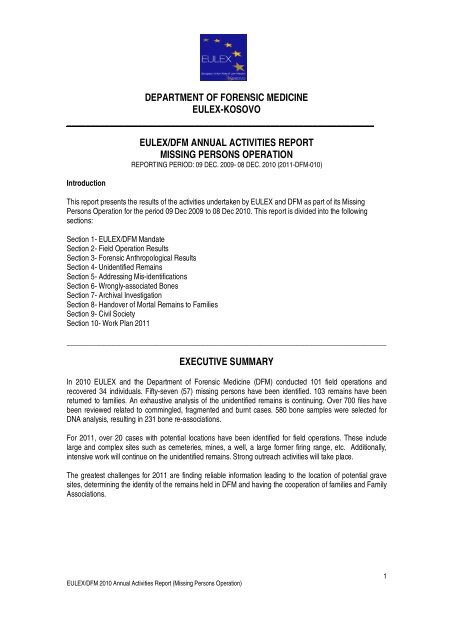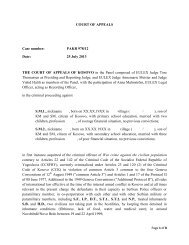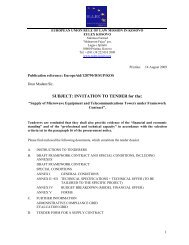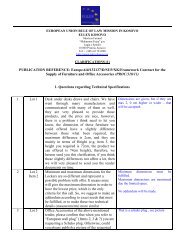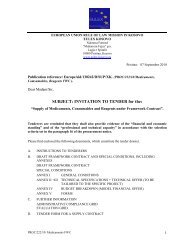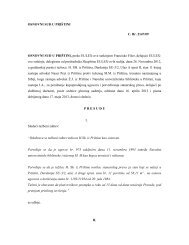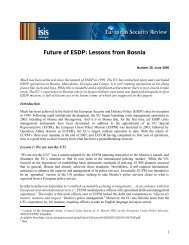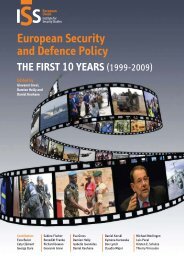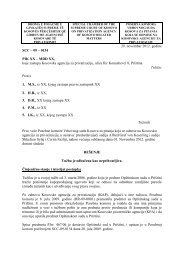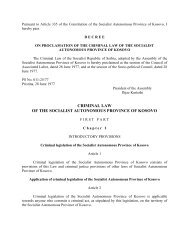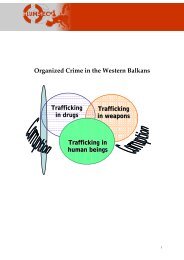DEPARTMENT OF FORENSIC MEDICINE EULEX-KOSOVO EULEX ...
DEPARTMENT OF FORENSIC MEDICINE EULEX-KOSOVO EULEX ...
DEPARTMENT OF FORENSIC MEDICINE EULEX-KOSOVO EULEX ...
You also want an ePaper? Increase the reach of your titles
YUMPU automatically turns print PDFs into web optimized ePapers that Google loves.
<strong>DEPARTMENT</strong> <strong>OF</strong> <strong>FORENSIC</strong> <strong>MEDICINE</strong><br />
<strong>EULEX</strong>-<strong>KOSOVO</strong><br />
_________________________________________________________________<br />
Introduction<br />
<strong>EULEX</strong>/DFM ANNUAL ACTIVITIES REPORT<br />
MISSING PERSONS OPERATION<br />
REPORTING PERIOD: 09 DEC. 2009- 08 DEC. 2010 (2011-DFM-010)<br />
This report presents the results of the activities undertaken by <strong>EULEX</strong> and DFM as part of its Missing<br />
Persons Operation for the period 09 Dec 2009 to 08 Dec 2010. This report is divided into the following<br />
sections:<br />
Section 1- <strong>EULEX</strong>/DFM Mandate<br />
Section 2- Field Operation Results<br />
Section 3- Forensic Anthropological Results<br />
Section 4- Unidentified Remains<br />
Section 5- Addressing Mis-identifications<br />
Section 6- Wrongly-associated Bones<br />
Section 7- Archival Investigation<br />
Section 8- Handover of Mortal Remains to Families<br />
Section 9- Civil Society<br />
Section 10- Work Plan 2011<br />
______________________________________________________________________________________<br />
EXECUTIVE SUMMARY<br />
In 2010 <strong>EULEX</strong> and the Department of Forensic Medicine (DFM) conducted 101 field operations and<br />
recovered 34 individuals. Fifty-seven (57) missing persons have been identified. 103 remains have been<br />
returned to families. An exhaustive analysis of the unidentified remains is continuing. Over 700 files have<br />
been reviewed related to commingled, fragmented and burnt cases. 580 bone samples were selected for<br />
DNA analysis, resulting in 231 bone re-associations.<br />
For 2011, over 20 cases with potential locations have been identified for field operations. These include<br />
large and complex sites such as cemeteries, mines, a well, a large former firing range, etc. Additionally,<br />
intensive work will continue on the unidentified remains. Strong outreach activities will take place.<br />
The greatest challenges for 2011 are finding reliable information leading to the location of potential grave<br />
sites, determining the identity of the remains held in DFM and having the cooperation of families and Family<br />
Associations.<br />
<strong>EULEX</strong>/DFM 2010 Annual Activities Report (Missing Persons Operation)<br />
1
SECTION 1- <strong>EULEX</strong>/DFM MANDATE<br />
<strong>EULEX</strong> is the European Rule of Law Mission in Kosovo, established by the Council Joint Action<br />
2008/124/CFSP on the 4 th of February, 2008. The Mission was approved by the Kosovo Government and<br />
the 27 Member States of the European Union with a mandate to assist the Kosovo judicial authorities and<br />
law enforcement agencies in their progress towards sustainability and accountability. The Mission became<br />
operational on the 9 th December 2008.<br />
In June 2010, pursuant to the adoption of Law No. 03/L-137 issued by the Assembly of the Republic of<br />
Kosovo, OMPF was transformed into the “Department of Forensic Medicine” under the Kosovar Ministry of<br />
Justice. The DFM was established “as the competent public authority responsible for providing forensic<br />
medicine and medical death investigation expertise, including exhuming the human remains related to the<br />
armed conflict in Kosovo and returning the remains to the families”.<br />
The Department of Forensic Medicine (DFM) is the scientific institution of the Ministry of Justice specializing<br />
in a diverse range of forensic fields. Its principal objectives are:<br />
To determine the fate of the Missing as a result of the conflict in Kosovo and its aftermath,<br />
To strengthen the Rule of Law in Kosovo by providing scientifically sound physical evidence which<br />
may aid in the search for justice,<br />
To be at the forefront of Forensic related developments in Kosovo and the Balkan Region.<br />
<strong>EULEX</strong> forensic experts work in partnership with MoJ experts in DFM to assist in the search for the Missing<br />
and to develop a sustainable and effective forensic medicine system. As of 09 th December 2008, <strong>EULEX</strong><br />
assumed its monitoring, mentoring, advising and executive functions within DFM. To carry out their<br />
mandate, <strong>EULEX</strong> experts work in close coordination with their Ministry of Justice/DFM counterparts.<br />
The DFM has the following dual mandate:<br />
1) To clarify the fate of missing persons:<br />
Assess and exhume suspected graves,<br />
Perform autopsies of unidentified remains in order to determine cause of death whenever<br />
possible and complete identification in a professional manner, using DNA analysis whenever<br />
necessary,<br />
Keep the families of the Missing informed on the progress and return the identified remains to<br />
their families in a timely and respectful manner,<br />
Keep up-to-date records and statistics on missing persons in Kosovo.<br />
2) To provide a medico-legal system in Kosovo of European standards, including but not exclusively<br />
limited to the following specialties:<br />
Medical examinations of victims of sexual/physical offences,<br />
Autopsies in cases of suspected non-natural death,<br />
Cases of medical malpractice,<br />
Toxicological analysis,<br />
Histo-pathological analysis,<br />
Medico-legal analysis of crime scenes.<br />
DFM has established a coherent system of working procedures and protocols on exhumations, autopsy,<br />
identifications, returns of remains, and mortuary work, which respects the requirements of the judiciary<br />
system and the needs of families.<br />
<strong>EULEX</strong>/DFM 2010 Annual Activities Report (Missing Persons Operation)<br />
2
Resolving the fate of missing persons in Kosovo is an extremely lengthy and complex task exacerbated by<br />
the particularly sensitive social and political context. Through the systematic audit of the records, the closure<br />
of cases of persons no longer missing, the continuous search and exhumations of graves, the identification<br />
and return of remains, the number of missing persons has been reduced from 5236 (figures in June 2002) to<br />
1821 (official figures in December 2010). This means that 3415 Missing (65%) have been accounted for<br />
in 8 years.<br />
1.1 <strong>EULEX</strong>-DFM POLICY ON THE ISSUE <strong>OF</strong> THE MISSING:<br />
The investigation and resolution of the issue of the Missing as a result of the conflict in Kosovo and its<br />
aftermath is of the utmost priority for <strong>EULEX</strong> and DFM. The difficult problems surrounding cases of missing<br />
persons demand a prompt, uniform and continuous response. Investigations, together with public outreach<br />
activities are and will be timely and comprehensive.<br />
Whilst over 65% of the Missing has been found, as of the date of issuance of this document, there remain<br />
1821 persons unaccounted for in Kosovo. Investigations are commonly faced with cases that generally lack<br />
significant investigative leads. The investigative problems are compounded by the passage of time: a<br />
decade since most disappearances occurred. The investigative complexities make it necessary to actively<br />
interact with and involve relevant civil society sectors in an effort to create new avenues of enquiry.<br />
It is <strong>EULEX</strong>-DFM’s Policy to ensure:<br />
That all reports are fully investigated,<br />
A full case-record is created and updated as new information becomes available,<br />
Every appropriate tool available to DFM be used to assist in the investigation,<br />
Every relevant coordination is made with other departments and relevant units,<br />
Families of the Missing be kept duly informed of the status of investigations. All efforts are to<br />
be made to re-assure families that investigative and available forensic methods are being<br />
utilized,<br />
Information be made available to Families and Family Associations,<br />
Appropriate and accurate media relations are maintained regarding the Missing and unidentified<br />
remains,<br />
No case will be closed until the Missing Person’s fate is determined.<br />
SECTION 2- FIELD OPERATIONS RESULTS<br />
DFM has conducted an intensive field season which has resulted in 101 field operations, resulting in the<br />
recovery of 34 individuals. Over 20 new potential grave sites have been ear-marked for further investigation<br />
in 2011.<br />
The cooperation of many Family Associations has played a crucial role in achieving the results so far,<br />
particularly in the suspected cases of mis-identifications from 1999. The following map and tables 1 and 2<br />
show the geographical distribution of field operations:<br />
<strong>EULEX</strong>/DFM 2010 Annual Activities Report (Missing Persons Operation)<br />
3
2 Field Operations<br />
2 individuals recovered<br />
10 Field Operations<br />
6 individuals recovered<br />
Map 1- NUMBER <strong>OF</strong> FIELD OPEATIONS AND INDIVIDUALS RECOVERED BY REGION<br />
Peja/Pec<br />
Gjakovë/Djakovica<br />
Mitrovicë/ Mitrovica<br />
Prizren/Prizren<br />
<strong>EULEX</strong>/DFM 2010 Annual Activities Report (Missing Persons Operation)<br />
Prishtinë/Pristina<br />
Ferizaj/Urosevac<br />
28 Field Operations<br />
2 individuals recovered<br />
20 Field Operations<br />
13 individuals recovered<br />
Gjilan/Gnjilane<br />
- 10 or more field operations<br />
- 9 or less field operations<br />
- 5 or less field<br />
operations<br />
25 Field Operations<br />
9 individuals recovered<br />
5 Field Operations<br />
1 individual recovered<br />
4 Field Operations<br />
12 individuals recovered<br />
4
Table 1: Field Operations by Region Table 2: Field Operations by Municipality<br />
Region Field- Individuals<br />
operations recovered<br />
Mitrovica 20 13<br />
Prishtina 25 9<br />
Gjilan 4 1<br />
Peja 2 2<br />
Prizren 28 2<br />
Ferizaj 5 1<br />
Gjakova 10 6<br />
Total 94 34<br />
2.1 SUSPECTED SITES OUTSIDE <strong>KOSOVO</strong><br />
<strong>EULEX</strong> and DFM representatives attended as observers the following site assessments in Serbia:<br />
Table 3: Sites Visited as Observers<br />
Alleged Site Date Status<br />
Medvedja 29 April Pending<br />
Rudnice 25 June Negative<br />
Rudnice 08 July Negative<br />
Perucac 09 August Negative<br />
Rudnice 22 September Negative<br />
<strong>EULEX</strong> will continue to ask the Serbian authorities to check potential sites such as Rudnice, in a scientific<br />
and systematic way, using the appropriate methodologies and techniques.<br />
An alleged site was excavated jointly by <strong>EULEX</strong> and the Montenegrin authorities from the 19 th to the 27 th of<br />
July in the town of Andrijevica. The result was negative.<br />
<strong>EULEX</strong>/DFM 2010 Annual Activities Report (Missing Persons Operation)<br />
Municipality Field- Individuals<br />
operations recovered<br />
Deçan 3 0<br />
Gjakova 4 6<br />
Ferizaj 3 1<br />
Gjilan 1 1<br />
Drenas 0 0<br />
Istog 0 0<br />
Kaçanik 2 0<br />
Kamenica 1 0<br />
Klina 0 0<br />
Lipjan 3 2<br />
Malisheva 0 0<br />
Mitrovica 4 1<br />
Podujeva 7 2<br />
Peje 2 2<br />
Prizren 19 1<br />
Prishtina 15 5<br />
Rahovec 3 0<br />
Skenderaj 1 1<br />
Suhareka 9 1<br />
Viti 2 0<br />
Vushtrri 14 11<br />
Zubin Potok 1 0<br />
Total 94 34<br />
5
Contacts were made with Macedonian and Albanian authorities concerning potential graves located on their<br />
territories.<br />
SECTION 3- <strong>FORENSIC</strong> ANTHROPOLOGY RESULTS<br />
As a result of the identification work conducted at <strong>EULEX</strong>/DFM, 103 individuals were positively identified in<br />
2010, 57 of which were missing persons.<br />
Forensic Anthropological work resulted in the selection of 580 bone samples for further analysis including<br />
genetic profiling conducted by ICMP. Additionally, 231 bone samples were re-associated to other<br />
individuals.<br />
A detailed analysis and evaluation of several cases of commingled and burnt remains from several regions<br />
in Kosovo was conducted. An identical exercise was conducted with thousands of fragmented body parts<br />
from the sites exhumed in Serbia (Bajna Basta, Petrovo Selo and Batajnica). This work was conducted in<br />
conjunction with the review of over 700 files.<br />
SECTION 4- UNIDENTIFIED REMAINS<br />
4.1 INTRODUCTION<br />
The identification of the bodies and body-parts under DFM custody is of the highest priority and forms an<br />
essential component of DFM’s strategy. To this end, DFM has worked intensively in the review of every<br />
single case and has made considerable progress. Additionally, over 580 new bone samples have been sent<br />
to ICMP for DNA analysis. For the last 12 months <strong>EULEX</strong>-DFM continued to work intensively on the issue of<br />
the unidentified remains held in the morgue. The work has been labour-intensive and highly complex. The<br />
task is not finished since it requires further detailed analysis and the cooperation of Civil Society.<br />
4.2 A GUIDE TO UNDERSTANDING THE UNIDENTIFIED REMAINS AT THE DFM- Kosovo Cases<br />
There are 250 bodies.<br />
There are 101 body parts.<br />
There are 168 male bodies vs. 82 female bodies. There are 80 male body-parts vs. 21 female<br />
body-parts.<br />
All have been profiled by ICMP (all have a DNA “finger print”). However for a large number of<br />
cases, these profiles are several years old. We strongly suggest that problem cases are re-profiled<br />
using new technology and methods offered by ICMP or other labs.<br />
In 2009 and 2010, sixteen (16) samples sent in 2002 and 2003 were finally matched to blood.<br />
These cases took 7-8 years for a match to be made.<br />
For the rest of the bodies and body-parts, none of them have so far matched the blood data base,<br />
so they remain un-identified.<br />
If relatives have not given blood: their missing person could be at the DFM.<br />
We know that there are more than 250 incomplete blood samples. There are also 61 cases for<br />
which there is no blood at all.<br />
In total there are 311 cases which cannot be identified because we do not have the blood for<br />
comparison.<br />
Some of the remains buried during and after the conflict were possibly MIS-IDENTIFIED and that<br />
they may actually be missing persons, while the remains at DFM are those of persons who were<br />
never reported as missing (See Section 5: Addressing Potential Mis-identifications below).<br />
<strong>EULEX</strong>/DFM 2010 Annual Activities Report (Missing Persons Operation)<br />
6
Table 4: By Municipality Table 5: By Region<br />
Municipality Bodies Body-parts<br />
Deçan 2 9<br />
Gjakova 27 14<br />
Ferizaj 3 0<br />
Gjilan 2 1<br />
Drenas 1 1<br />
Istog 2 17<br />
Kaçanik 4 1<br />
Kamenica 2 0<br />
Klina 3 0<br />
Lipjan 0 1<br />
Malisheva 3 1<br />
Mitrovica 23 8<br />
Podujeva 2 1<br />
Peje 23 18<br />
Prizren 34 7<br />
Prishtina 82 9<br />
Rahovec 8 2<br />
Skenderaj 3 7<br />
Suhareka 14 2<br />
Vushtrri 12 2<br />
Total 250 101<br />
<strong>EULEX</strong>/DFM 2010 Annual Activities Report (Missing Persons Operation)<br />
Table 6: Sites from Serbia<br />
Table 6 displays the number of DNA profiles without a match from the mass graves located in Serbia in<br />
2001, 2002, and 2003. A total of 26 unique profiles (26 individuals) remain to be identified. They have not<br />
been identified yet because they have not yet been matched with blood samples in the blood data base.<br />
4.3 CURRENT ACTIVITIES:<br />
Region Bodies Body-parts<br />
Mitrovica 38 17<br />
Prishtina 85 12<br />
Gjilan 4 1<br />
Peja 28 35<br />
Prizren 51 10<br />
Ferizaj 7 1<br />
Gjakova 37 25<br />
Total 250 101<br />
Site DNA Profiles<br />
Banja Basta 3<br />
Batajnica 6<br />
Batajnica 03 6<br />
Batajnica 05 6<br />
Batajnica 07 5<br />
Total 26<br />
As during 2009, in 2010 <strong>EULEX</strong>-DFM liaised with family associations throughout Kosovo to find families,<br />
which may harbour a doubt about the identity of the remains that they buried without scientific support. We<br />
are first focusing on events which had the conditions which usually led to mis-identifications. The strategy<br />
however, goes deeper than that: Once potential families have been determined DFM staff approach them<br />
and the situation is described and explained in great detail. Cases tend to be unique in their circumstances<br />
so that each one merits an individual approach. In many cases, all that is required is a blood sample; in<br />
others both a blood and a bone sample is required, whilst in others a full exhumation and autopsy is<br />
needed. (See Section 5: Addressing Potential Mis-identifications below).<br />
7
Map 2- BODIES AND BODY-PARTS BY REGION<br />
Peja/Pec<br />
63<br />
Gjakovë/Djakovica<br />
62<br />
Mitrovicë/Mitrovica<br />
Prizren/Prizren<br />
61<br />
55<br />
<strong>EULEX</strong>/DFM 2010 Annual Activities Report (Missing Persons Operation)<br />
Prishtinë/Pristina<br />
97<br />
Ferizaj/Urosevac<br />
8<br />
Gjilan/Gnjilan<br />
e<br />
5<br />
8
SECTION 5: ADDRESSING POTENTIAL MIS-IDENTIFICATIONS<br />
Correcting cases of potential mis-identifications from 1999 and 2000 is a lengthy process requiring<br />
considerable tact in contacting families, family associations and community leaders, patience and attention<br />
to detail in analyzing documents and the situation on the ground, including existing cemeteries and potential<br />
burial places.<br />
The DFM’s strategy to address the issue of potential mis-identification includes the following actions:<br />
Exhumation of remains upon request by family members for confirmation of identity with the help<br />
of DNA testing<br />
DNA analysis of spare ICTY samples collected in 2000<br />
Analysis and review of specific events such as Pastasel/Pusto Selo, Rezalla/Rezala,<br />
Makermal/Makrmalj, Bishtrazhin/Bistazin, Studime, Dubrava, etc. Collect of blood and<br />
exhumations if required.<br />
5.1 EXHUMATIONS REQUESTED BY FAMILIES<br />
In 2004, DFM (at the time OMPF) started to accept requests from families to exhume the remains of alleged<br />
relatives killed during the conflict in order to confirm the identity with DNA analysis. <strong>EULEX</strong> DFM continues<br />
this necessary work. The criteria to accept such requests are the following:<br />
- Event date. The presumed victim was killed during the conflict.<br />
- The nature of the event (ambushes, check points, shelling of villages, etc).<br />
- The number of victims resulting from the event.<br />
- The level of decomposition of the remains.<br />
- Who claimed to recognize the remains?<br />
- Who buried the remains?<br />
- There are reasonable doubts regarding the identity of the body.<br />
- Included are the cases where families or neighbours that found remains on the surface.<br />
Since 2004, 109 remains were exhumed on the request of families. The DNA profiling is pending for 5 of<br />
these cases, 11 of the remaining 109 cases were mis-identified (approx 11%).<br />
In 2010, on a total of 34 bodies recovered from January until mid November, 12 bodies were exhumed on<br />
the request of the families.<br />
Years Total bodies<br />
exhumed<br />
Table 7: Mis-identification Data by Year<br />
Bodies exhumed by family request<br />
(% of such cases compared to<br />
total number)<br />
<strong>EULEX</strong>/DFM 2010 Annual Activities Report (Missing Persons Operation)<br />
Number of mis-identifications<br />
(% of mis-id compared with number exhumed<br />
on request of family)<br />
2004 121 13 (11%) 0 (0%)<br />
2005 112 0 (0%) n/a<br />
2006 59 11 (19%) 1 (9%)<br />
2007 73 22 (30%) 2 (9%)<br />
2008 53 16 (30%) 2 (12.5%)<br />
2009 101 35 (35%) 3 (8.6%)<br />
2010 34 12 (30%) 3 (n/a)<br />
Total 553 109 (18.5%) 11 (10.6%)<br />
All remains are autopsied and bone samples are sent with associated presumptive identity for DNA testing.<br />
In average, DFM receives three requests a month and has currently two requests pending exhumations.<br />
9
5.2 ICTY “SPARE SAMPLES”<br />
In 2000, ICTY collected bone samples for future DNA analysis. At the close of ICTY operation, these<br />
samples were handed-over to UNMIK. When OMPF was created in 2002, the samples cut from NN bodies<br />
were sent to ICMP for DNA analysis. The samples belonging to bodies already identified and returned to the<br />
families in 2000 (referred here below as “spare samples”) were kept at the mortuary.<br />
In 2006, DFM sent a spare sample for DNA analysis on the request of the family who wanted to confirm the<br />
identity of a body buried in 2000. The identity was confirmed. Two more spare samples were sent in 2008,<br />
again on the request of the families. The identities were again confirmed.<br />
In 2009, DFM started to send spare samples without request from family members. DFM focused on two<br />
sites in Skenderaj/Srbica municipality, namely Makermal/Makrmalj and Rezalla/Rezala, where DFM<br />
suspected that some mis-identifications might have occurred. Out of 48 spare bone samples sent for DNA<br />
analysis, 29 were associated with presumptive identities, the families having agreed to give blood. Out of<br />
these 29 samples, 18 results confirmed the initial identification made in 2000, four results were negative and<br />
7 are still pending. The 19 samples sent without presumptive identity have not been matched with any blood<br />
references to date.<br />
One negative result was received for Makermal/Makrmalj. The mis-identified body was exhumed and the<br />
correct one was returned to the family (see para. 5 below).<br />
DFM is continuing the analysis of Rezalla/Rezala site and additional families will be contacted for blood<br />
collection with the hope that the three mis-identifications will be corrected.<br />
Other sites will then be considered for review and analysis and more spare samples might be sent for DNA<br />
testing.<br />
5.3 ANALYSIS BY EVENT – 1: PASTASEL/PUSTO SELO (MUNICIPALITY <strong>OF</strong> RAHOVEC/ORAHOVAC)<br />
Pastasel/Pusto Selo was the first event mentioned in the SWG (in 2006) as a potential test for cases of misidentifications.<br />
106 bodies were buried by families in 1999. 96 of these bodies were then exhumed by Serbian forensic<br />
teams to be autopsied and reburied in various cemeteries in different municipalities. These cemeteries were<br />
then re-exhumed either directly by families looking for their missing relatives or by ICTY in 1999. Most of the<br />
recovered bodies were identified based on clothing, among them 56 belonged to victims of Pastasel/Pusto<br />
Selo event. Between 2000 and 2009, 37 additional bodies were identified with DNA as victims of this event.<br />
At the beginning of 2010, 13 men were still considered missing from Pastasel/Pusto Selo event and DFM<br />
had the bones of a minimal number of 28 unidentified males (bodies and body parts) recovered from<br />
cemeteries where other Pastasel/Pusto Selo victims had been found (Prizren – Tusus Cemetery,<br />
Shiroko/Siroko Cemetery, Serbice e Poshtme/Donja Srbice, etc). The blood profile of the relatives of the 13<br />
missing men did not match the bone profiles of any of the remains at the morgue. The remains of these men<br />
have most likely been buried under the wrong identity by other families<br />
Nevertheless, most of the families were opposed to the re-exhumation of their relatives for new autopsy and<br />
DNA testing. As a matter of fact, no family from Pastasel/Pusto Selo ever approached DFM with a request<br />
for re-exhumation. The best alternative was to collect blood samples from as much families as possible in<br />
order to compare these blood profiles with the profiles of the NN bodies under DFM custody. Obviously, this<br />
would not clear all cases of mis-identifications, but only those where the correct remains lie at the morgue.<br />
<strong>EULEX</strong>/DFM 2010 Annual Activities Report (Missing Persons Operation)<br />
10
The case of Pastasel/Pusto Selo presents a particular challenge: since victims were buried in different<br />
municipalities, along other victims from other places and events, potential mis-identifications are not only<br />
internal to the event. There might be occurrences of cross-events mis-identifications.<br />
In February 2010, DFM started to systematically contact families. A certain number of families refused to<br />
give blood but the contacts of those who accepted were sent to ICMP. So far, blood references were<br />
collected from 18 families and DFM has already received DNA result showing mis-identification in three<br />
cases as the blood profiles of the relatives match the profile of unidentified bones under DFM custody.<br />
- Name withheld (DNA match with previously NN body HP35-001B)<br />
- Name withheld (DNA match with previously NN body YMI12-001B)<br />
- Name withheld (DNA match with previously NN body KRO01-001B)<br />
The remains wrongly buried under these three (withheld) identities will be exhumed in the coming weeks<br />
and the correct remains will be handed-over to the families. DFM hopes these three cases will encourage<br />
other families to give blood or even request the re-exhumation of the remains buried under their relatives<br />
name to check the identity with DNA analysis.<br />
5.4. ANALYSIS BY EVENT – 2: STUDIME, MUNICIPALITY <strong>OF</strong> VUSHTRRI/VUCITRN<br />
In the case of Studime Cemetery, the mis-identifications are mostly internal, i.e. within the group of 96<br />
victims killed on the 02 May 1999, but might also include some other war victims buried in the same<br />
cemetery.<br />
All remains present in the cemetery were buried by villagers, and some of them were exhumed in 1999 by<br />
ICTY and reburied after autopsies in the same cemetery. The graves of two victims of the 02 May event<br />
could not be located and the families reported them missing. In addition, ICTY reports mention the presence<br />
of few NN bodies, some of them might have been identified by family members later on.<br />
In 2002 and 2003, OMPF/DFM exhumed three unidentified bodies from the cemetery (these bodies are still<br />
unidentified). In the following years, DFM exhumed six more bodies on the request of the families, but the<br />
identities of only two of them could be confirmed. A third body was recently identified as a victims killed after<br />
the 02 May 1999. As a result of these successive exhumations, DFM had 6 unidentified bodies and 6<br />
persons reported missing, but no match between blood and bone profiles.<br />
Some discrepancies and permutations were also noticed between the initial burial sketch drawn by the<br />
villagers and the ICTY reports on the exhumations done in 1999. In addition, the layout of the cemetery was<br />
drastically modified between 2004 and 2010. The remains were initially buried in 15 parallel lines, closely<br />
spaced and each line containing between 4 and 7 bodies. In 2004, families started to build grave, but<br />
without taking into account the initial burials lay-out. The concrete frames and graves were only<br />
approximately placed over the initial burial area. It became impossible to locate any remains with certainty.<br />
In order to identify the 6 unidentified remains, DFM started to contact families from Studime event to advise<br />
them to give blood. The families were chosen on the basis of the location of the graves of their dead<br />
relatives. A substantial number refused to give blood, the contacts of those who have accepted were<br />
forwarded to ICMP. In parallel, DFM also decided to exhume graves in order to collect samples for DNA<br />
analysis with the aim to locate the remains of the current 6 missing persons.<br />
So far, two samples were sent and the exhumations are on-going.<br />
5.5 ANALYSIS BY EVENT: OTHER CASES<br />
In addition to Pastasel/Pusto Selo and Studime, DFM works on the following events: Bishtazhin/Bistazin,<br />
Rezalla/Rezala and Makermal/Makrmalj. We plan to start soon the analysis of Dubrava event.<br />
<strong>EULEX</strong>/DFM 2010 Annual Activities Report (Missing Persons Operation)<br />
11
5.5.1 Bishtazhin/Bistazin, Municipality of Gjakova/Djakovica<br />
A number of unidentified bodies and body parts exhumed by ICTY in Gjakova/Djakovica cemetery are still<br />
unidentified (site code CZ). In 2008, DFM started to contact families of victims from Bishtazhin/Bistazin<br />
event in order to advise them to give blood. So far relatives have given blood references for 16 victims. Six<br />
remains were exhumed, the identities of five of them were confirmed and one identification is pending. DFM<br />
will continue to contact families for blood collection.<br />
5.5.2 Rezalla/Rezala, Municipality of Skenderaj/Srbica<br />
(See para 2 above) DFM will send more spare samples and additional families will be contacted for blood<br />
collection.<br />
5.5.3 Makermal/Makrmalj, Municipality of Skenderaj/Srbica<br />
(See para 2 above) In 2007, OMPF/DFM exhumed the remains buried under the name of (withheld) to<br />
confirm the identity. The identification was negative and DFM started to contact families from<br />
Makermal/Makrmalj event to advise them to give blood. As the cemetery was exhumed by ICTY in 2000<br />
(site code ZF and RY), DFM had spare samples and could send six of them without exhuming remains.<br />
Three identifications were confirmed, two are pending and one was negative, but was later on identified as<br />
the body initially buried under someone else’s name.<br />
5.5.4 Mis-identification Chain<br />
Research on mis-identifications has revealed a previously unknown level of complexity. In 2010 a chain of<br />
mis-identifications was discovered. This is explained below (real names have been omitted:<br />
A body believed to be Victim “A” was buried by Family “A” in Suha Reka in 1999.<br />
However, OMPF found and identified the real Victim “A” in 2007 in Serbica I Ulet. OMPF then informed the<br />
family and the bodies were exchanged.<br />
The exhumed body was transferred to the OMPF mortuary where it was recently identified in 2010 as Victim<br />
B from Pastasel.<br />
However, a body believed to be Victim “B” was buried by Family “B” in Suha Reka in 1999.<br />
DFM has arranged for this new exchange of bodies. Once exhumed, the body wrongly identified as Victim<br />
“B” will be autopsied by DFM and bone samples will be sent for DNA analysis.<br />
Both bodies were initially buried in the same cemetery in Suha Reka in the Spring 1999. They were only a<br />
few meters away from each other. The cemetery was exhumed by ICTY in Summer 1999 and the remains<br />
were returned to presumptive families. Victims A and B were therefore never reported missing.<br />
However, the son of the real Victim “A”, who was reported missing in 2001, was eventually found in Tusus<br />
cemetery in 2004 and identified in 2009. The identification of both Victim “A” and his son was only possible<br />
because there were blood references available for DNA matching.<br />
This is why it is important for families to donate blood samples when DFM requests them, even if they do<br />
not have missing relatives.<br />
<strong>EULEX</strong>/DFM 2010 Annual Activities Report (Missing Persons Operation)<br />
12
5.6 CONCLUSION<br />
Mis-identifications might concern up to 11% of the remains buried by families in 1999 and 2000 without<br />
scientific identification. Almost none of these victims were reported missing and the families did not give<br />
blood. Mis-identifications are not frequent enough to justify systematic re-exhumations of all the remains<br />
buried in 1999, a process that could cause unnecessary trauma and pain for the families concerned. On the<br />
other hand, their number is not negligible and the remains wrongly buried might belong to a person reported<br />
missing while in turn the correct body might lie among the unidentified remains currently at DFM mortuary.<br />
Each case of potential mis-identification merits an individual approach and strategy.<br />
In most of the cases, the first step consists in collecting blood sample and Ante-Mortem information and<br />
available spare samples are sent for DNA analysis. Exhumations are only performed when necessary or if<br />
requested by family members.<br />
SECTION 6- WRONGLY ASSOCIATED BONES<br />
The case review conducted by <strong>EULEX</strong> has shown that in some cases, some bones were wrongly<br />
associated to some bodies. This happened in particular with cases of mass graves which had many mixed<br />
bodies and body-parts. The case which is worst affected is the Perucac Lake mass grave (aka Bajna Basta)<br />
in Serbia. The issue is described below:<br />
6.1 THE PERUCAC LAKE CASE:<br />
Once the mass grave was located, the bodies and body-parts were exhumed and autopsied by the Serbian<br />
authorities. As the autopsy and identification work was finished remains were transferred to Kosovo on<br />
different dates. In Kosovo, international experts from OMPF determined that further forensic work was<br />
needed. Forensic inspections were conducted. It was found that mistakes had been made in the original<br />
autopsies, mainly in determining the cause of death and in determining how many victims were present. The<br />
table below shows the difference in number of victims:<br />
Transfer<br />
#<br />
Table 8: Perucac Lake Case- Transfers from Serbia to Kosovo<br />
Date<br />
Number of Victims claimed to<br />
be handed over by Serbia<br />
<strong>EULEX</strong>/DFM 2010 Annual Activities Report (Missing Persons Operation)<br />
Real number of<br />
victims determined by<br />
OMPF<br />
1<br />
16 December<br />
2004<br />
12 15<br />
2<br />
07 September<br />
2005<br />
8 10<br />
3<br />
25 November<br />
2005<br />
3 5<br />
4 30 June 2006 18 20<br />
The Serbian authorities also handed over several body bags with mixed bones from several unidentified<br />
persons. However, the DNA technology available to ICMP at the time restricted the type of samples that<br />
could be sent for profiling.<br />
When <strong>EULEX</strong> began work at the DFM in December 2008 it chose many more types of bones for the<br />
demineralization technique. Given that there are a number of missing persons from the events linked to this<br />
mass grave, it became necessary to sample a large number of bones (200 samples in 2009 and 200 in<br />
2010).<br />
13
Of the 400 samples sent for further analysis, 4 new identifications were made. Over 320 samples resulted in<br />
re-associations to individuals already identified while 50 samples failed. Around 26 samples are pending a<br />
result.<br />
<strong>EULEX</strong> research has shown that the Serbian authorities re-associated bones without DNA analysis. These<br />
bodies were handed over to Kosovo and since there was no possibility to detect the problem at the time,<br />
bodies were handed over to the families with a few bones that did not belong to them. <strong>EULEX</strong> has so far<br />
determined 15 cases like this.<br />
6.2 WHAT MUST BE DONE<br />
The bones which were wrongly associated must be recovered and tested with DNA. <strong>EULEX</strong> believes that<br />
while it is likely that most of the bones will result in re-associations, we are hopeful that new identifications<br />
may be made.<br />
Graves will be opened. The bones which were wrongly associated will be taken from the remains in the<br />
grave (meaning that no exhumation will take place). Samples for new DNA analysis will be taken from arm,<br />
leg and head bones.<br />
Any new re-associations will be re-united and any new identification would be processed as normal (See<br />
Section 10: Work Plan 2011).<br />
SECTION 7- ARCHIVAL INVESTIGATIONS<br />
DFM has achieved considerable progress in the analysis of the 85,000 pages of ICTY reports. These<br />
documents include reports on death scene investigations, exhumations and autopsies of identified and<br />
unidentified victims conducted by the tribunal in 1999 and 2000. They do not consistently provide<br />
information on the location of where victim’s bodies were last buried or who they were handed over to, but<br />
they provide new leads of investigation which <strong>EULEX</strong>/DFM is following in its efforts to locate gravesites.<br />
This type of data is combined with several other sources of partial data to build the most complete<br />
information possible. During 2010, many ICTY cases were screened for their usefulness; the ones with the<br />
most potential were prioritized for further action, which in some cases included site assessments and<br />
exhumations. The exhumations conducted at Novollan, Obrançë and Matiqan (where a total of 9 bodies and<br />
3 body parts were recovered) resulted from the analysis of ICTY and OMPF documents, together with<br />
several field assessments .This work will continue in 2011.<br />
Additionally, ICTY data is important in helping address the investigations into possible mis-identifications<br />
from 1999 and 2000.<br />
SECTION 8- HANDOVER <strong>OF</strong> REMAINS TO FAMILIES<br />
As soon as identification is made and certified by DFM, relevant family members are informed in person. In<br />
cases where only body parts are identified, DFM advises families to delay the hand-over and burial date<br />
until all possible body-parts are identified or a case is closed. This prevents unnecessary grief and expense<br />
to families. However, the final choice is always with the relatives. Some families decide to bury bones as<br />
soon as they are identified. In some cases additional bones are identified after the burial, DFM offers to reopen<br />
the grave in order to re-associate the bones if the family wishes.<br />
DFM handed 103 identified remains to families in 2010.<br />
<strong>EULEX</strong>/DFM 2010 Annual Activities Report (Missing Persons Operation)<br />
14
SECTION 9- CIVIL SOCIETY<br />
The participation of civil society, particularly Family Associations, in the process of the search for the<br />
missing is of vital importance to achieve results. Throughout 2010, DFM has fostered the exchange of<br />
information with Family Associations throughout Kosovo and beyond. We have found that members of civil<br />
society have important information which has provided us with new leads to alleged grave sites and specific<br />
details which have moved forward some of our investigations.<br />
<strong>EULEX</strong>/DFM met with families, Family Associations and other stake-holders on over 70 occasions in 2010.<br />
It is necessary to continue this level of communication with all family associations in 2011. <strong>EULEX</strong>/DFM will<br />
be proactive in this respect and it is hoped that families will choose to work with us. This is particularly<br />
important to achieve progress on the following:<br />
1. Locations of potential grave sites,<br />
2. Coordination with non-members who need to give blood samples for DNA analysis,<br />
3. Persuade families to provide blood for DNA analysis,<br />
4. Gathering of information on specific cases,<br />
5. Information exchange and general coordination,<br />
6. Support systematic cemetery surveys and similar projects.<br />
The greatest challenges for 2011 are finding reliable information leading to the location of potential grave<br />
sites, determining the identity of the remains held in DFM and having the cooperation of families and Family<br />
Associations.<br />
We encourage all those who may have information to approach us. All information provided is treated with<br />
the utmost confidentiality. <strong>EULEX</strong>/DFM will respond in a timely manner to all information provided.<br />
SECTION 10- WORK PLAN 2011<br />
<strong>EULEX</strong> seeks to completely transfer the Missing Persons Operation to the MoJ once <strong>EULEX</strong> has been<br />
satisfied that the complex tasks required can be conducted in a scientific, impartial and professional<br />
manner. The MoJ already manages a large proportion of the work. All the non-sensitive information<br />
produced by <strong>EULEX</strong> is shared with the local director and relevant staff. However, there is still no local<br />
capacity to deal with case investigation, exhumations and forensic anthropological work. In 2011, <strong>EULEX</strong><br />
will continue to strongly encourage the MoJ to develop the necessary local capacity required to responsibly<br />
handle the Missing Persons Operation.<br />
In 2011 <strong>EULEX</strong> and DFM will continue to work together to determine the fate of the missing. The work plans<br />
will consolidate on the work initiated in 2010. The priorities are the following:<br />
Targeted exhumation campaign. The main challenge for locating the missing remains the absence<br />
of reliable information. Around 18 sites have been ear-marked for assessment in 2011. These<br />
include working in some large cemeteries, and the search for at least two mass graves in Kosovo.<br />
<strong>EULEX</strong> will continue to conduct actions aimed at locating and reaching alleged grave sites beyond<br />
Kosovo’s borders.<br />
Implementation of a satellite imagery project to search for particular types of graves in close<br />
coordination with other <strong>EULEX</strong> units.<br />
Re-association and identification work related to the Batajnica and Bajna Basta cases will be<br />
concluded.<br />
In coordination with the relevant organizations, collect as much blood or bone samples as possible<br />
in order to complete partial blood samples.<br />
<strong>EULEX</strong>/DFM 2010 Annual Activities Report (Missing Persons Operation)<br />
15
In coordination with family associations and relevant organizations, design a policy for burial of<br />
identified extra body parts, unidentifiable remains (burnt or fragmented bones, etc) and identified<br />
remains refused by their family.<br />
Continuing efforts to identify the remains and close cases held at DFM.<br />
Close cases which reached the limits of forensic analysis (burnt cases – close cases of missing<br />
persons on the basis of circumstantial evidences whenever possible).<br />
Exhaust the possibilities of taking bone samples from all cases.<br />
Address the issue of wrong re-associations or re-association after hand-over in general.<br />
Monitor, mentor and advise MoJ on implementing a focused and intensive training: 2 local forensic<br />
trainees for exhumations and autopsies. It is imperative that the MoJ cooperates with <strong>EULEX</strong> in<br />
developing local sustainability.<br />
<strong>EULEX</strong>/DFM 2010 Annual Activities Report (Missing Persons Operation)<br />
16


